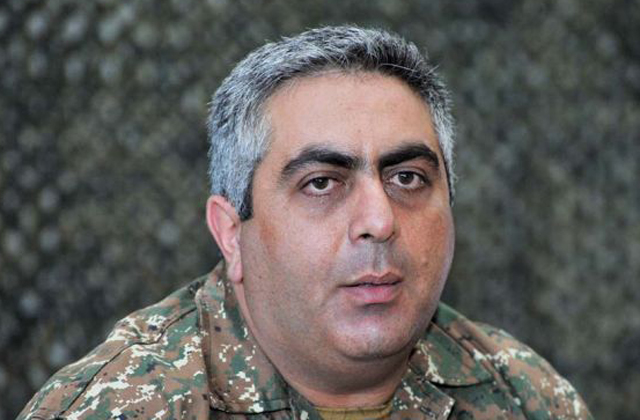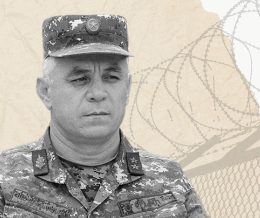
Analysis of the 4-Day April War

Political aspects of the causes of the start of the April war will be discussed for a long time: many geopolitical, economic and other reasons will be propounded, but the fact is that Azerbaijan has calculated several things. Over the past years Azerbaijan has purchased a large number of new types of weapons and had confidence that this modern weaponry would provide an inevitable victory. At the same time they knew that the Armenian side started major acquisitions, the huge part of which is still underway. If we add the fact that the spending of the Azerbaijani armed forces have been drastically reduced, then it can be assumed that this was the right time for them to try make a “blitzkrieg”.
From military aspect this April war still needs to be thoroughly analyzed, but several circumstances can definitely be mentioned. It’s obvious that during the past two years after failing all its previous sabotage reconnaissance actions (nearly 150 infiltration attempts), as well as applying landmine and artillery means that were also a failure, the Azerbaijani side tried to start large scale military actions. How can these actions be called? This is surely not a large-scale war, some people call it “spying by battling”, and this is to a certain extent right, however false in its classic meaning. Since the second half of the 1990s the tactics of striking on the basis of available forces without involving new forces and resources has been used in the military art.
This time Azerbaijan performed this kind of actions, trying to inflict an unexpected and decisive strike with the forces and resources it had in its operative layouts, planning to reach operational depth by infiltrating the tactical line. The one factor, that they would not be satisfied with the first tactical line, already means that this was not a reconnaissance battle. Besides, there is an interesting specificity.
The Azerbaijani media was completely silent till noon. From midday onwards they immediately started an aggressive informational downpour, moreover, at first with unconcealed pride they started reporting that they had assailed and occupied settlements and tactical lines. This means that the informational operations were also planned in advance in accordance with the military actions.
And the theoretical success of the Azerbaijani army should have been accompanied with informational materials but when those materials started to emerge as planned, they did not coincide with the real military actions. By the way, the same tactic was used by the Turkish media, which was probably also aware of the details. This is proved by the concentration in two main areas and primary focus on tank attacks in the relatively lowland territories, for instance, the disruptive attack by tanks and infantry in the direction of Seysulan. The strike directions assume that the strikes from the North and South to the direction of the North of Artsakh aimed at capturing Martakert, Sarsang water reservoir and other places. According to data provided by Azerbaijan, in every location attacks were led by one brigade of the 1-st echelon at a time, reinforced with special forces – up to two special sabotage units in total, highland rifle units, other tank and artillery forces.
In every direction considerable number of tanks was also concentrated. As we understand, the Azerbaijani side has the intention to reduce the size of its forces, which is also evidenced by the use of certain types of weaponry not controlled by the corps. It can be concluded that the forces were at least larger than brigades. The brigade backed up by such forces already had the potential of corps. This is also evidenced by the intensity of the Azerbaijani artillery attacks. Within 4 days the adversary has fired more than 30000 of 120-mm artillery shells, which is the number of ammunition expenditures envisaged for one “larger than average” strategic operation.
As a starting point it should be noted that the ammunition of one artillery system is about 60-80 shells, and if we calculate on the provision that one cannon can shoot one ammunition set daily the utmost, then it is apparent, that during 4 active days of full usage of each cannon there have been about 100 units of over-120mm cannons. In case of partial usage, which is more realistic, more than 150 cannons were exploited. With all this the Azerbaijani armed forces tried to use a trick, which has already expressed itself brilliantly several times in military art history. In the first line of the attacking groups only Special Forces were used, including the attempt of landing air troops into the tactical depth.
Тhe helicopter, which was downed in the morning of April 2, was hit during this attempt. This means that these groups had the task to seize the tactical lines or to provide openings and to simultaneously attack the battalion depth from the back and cause panic. The main armored means were acting along with the mobile groups in the second line, trying to act highly harmonically with the first groups. Acting in accordance with these rules and trying to disguise their attack in order to ensure the surprise factor, the Azerbaijani troops involved new forces and means in the process, having reserve forces in the tactical depth. However, since the first actions of the sabotage groups did not achieve full success, despite the fact that there were saboteurs in Talish village and in the back of several positions, the main strike forces were not able to fulfill their task.
This means that the way for the main strike forces was not opened, as it had been planned. Here the failure of plans and loss of harmony of strike forces began. Only in this direction, in the blockade, at least 30 soldiers of the Azerbaijani Special Forces were eliminated. Some positions successfully pushed back the attack or quickly regained losses thanks to counterattacks. The same scenario almost repeated in two fronts: 2 drones and 2 tanks were destroyed in Martakert. This means that not being able to overtake the Armenian units the adversary appealed to extreme methods, so called plan “B”, the tactics of taking the lead by intense artillery fire. Of course due to such intensive fire, the adversary managed to break through the first line, but it failed the entire operation. Not achieving significant success and not conquering any strategic depth the main forces had to conduct positional battles. Attempting to break through the defense line and failing this operation as well, they started to use heavy artillery cannons which were not planned to be involved because of their slowness.
Using armored vehicles, artillery, including MM -21 (“Grad”) type systems, the adversary targeted not only the positions of Armenian defense forces, but also peaceful civilian settlements in depth. In this direction on April 2 at 12:30 the air defense forces downed one military helicopter and hit two tanks of the adversary. Actually the Azerbaijani army failed its rapid military operations by the main attacking potential, which should have fractured the protection units by the help of enhanced brigades and infiltrate to the strategic depth. Even two-level higher, the Azerbaijani forces, attempting to strengthen on the frontiers of unit bases, were subjected to counterattacks by NKR Defense Army battalion and regimental reserves and even lost some positions there. In places where the Azerbaijani army managed to keep maximum squad positions it was only possible by attracting reserve corps.
Hence, Azerbaijan moved its actions to depletion dimension using old methods of bombing peaceful settlements. As the Azerbaijani Army did not plan this version, it was conducted even worse than a failed operation. From the beginning the Azerbaijani armed forces tried to achieve success relying on the large number of soldiers, but all their attempts were in vain. After the failure of each used methods, after each failed attack the Azerbaijani armed forces were trying to initiate new attacks, hoping to achieve success based on the number of soldiers and technical equipment. Based on this, the Azerbaijani army was transforming the war to a platform not in favor for their army. Gradually, the Azerbaijani army started to involve cannons, heavy artillery, and other types of arms, but as everything was poorly and unprofessionally planned, even the newest weaponry, such as combat UAVs were used not systematically, but individually, and the use of such equipment did not give expected results.
Azerbaijan used “Smerch” rocket launchers system against Karabakh, but interestingly even these were totally unsuccessful. It was totally strange that the Azerbaijani army tried to strike tanks and cars using combats UAVs. These weapons are for solving serious operational problems, and not for achieving success in positional battles. About 15 drone strikes were conducted, of which only one was successful: it hit a civilian bus. Other strikes were either ineffective or impractical, and two drone strikes were thwarted by anti-aircraft forces. Certainly these devices were to solve serious operational problems, but they haven’t been used correctly. However, since the positional battle became a problem of honor for the Azerbaijani army, they used every kind of means to occupy squadron foothold and trenches, or at least to protect occupied territories from Armenian counterattacks. Actually, the Azerbaijani army, except fighter jets, applied all other type of military equipment, though not operationally and, not in full scale, used the entire operational arsenal.
On the contrary the Armenian armed forces did not involve these type of military equipment during the battles, moreover, there was even no necessity to use the army reserves. After the failure of the rapid operation, Azerbaijan began depletion fighting. It is undeniable that Azerbaijan had some technical advantage, but it was not as big as at the last stage of the war. Azerbaijan was forced to the ceasefire, as during 2 days of depletion fighting it lost the main part of the army and military equipment, which were involved in the fight. At the time of the cease-fire agreement the Azerbaijani side had lost 24 tanks, 1 TOS -1 multiple rocket launcher, 1 ITU,6 armored cars, 1 engineering machine, 1 ‘Grad’ MLRS, 2 helicopters and 12 UAVs. Here it should be specially mentioned that the Armenian side lost only 1 UAV. Technical equipment of the Armenian side, particularly at Artsakh side was so dense, that practically it was impossible to move forward without great losses, and the large amount of losses is due to this fact. Besides, the troops were completely expanded due to the former tension conditions and based on reconnaissance data. The 4 day military actions showed that the Azerbaijani armed forces’ attacks on our battalions with their reinforced subdivision troops failed and even couldn’t move deep towards our battalions. On the 2nd day of military actions, the Azerbaijani troops used forces under operative command. Heavy cannons, military UAVs and “Smerch” systems are not under the control of the super-ordinate, thus, forces and facilities were used provided by 2-3 level higher commandment. In fact, on April 5, Azerbaijani armed forces used 2-3 times higher level forces to partially seize 2 positions of Artsakh Army. Even 10 times excessive Azerbaijani forces couldn’t solve the military task and had to endure the counterattacks of Armenian Army. Thus, the cease-fire was an attempt to replenish the consumption to involve new forces as they couldn’t implement expansive replenishment and force movements. The peculiarities of the actions of the Azerbaijani armed forces are the following:
- Operations planning of attacking groups, as well as the preparation of managing bodies were on low level.
- Azerbaijani army was equipped with modern weapons and military equipment, but they were not used correctly. This was especially demonstrated in the case of military drones and radio-technical equipment, as well as partial technical advantage in tank, antitank, long-range artillery and other hardware.
- Even a small number of military units had trouble in action coordination and management.
- The Azerbaijani army showed that it is unprepared for classic and moreover, innovative ways of the Art of War.
- The Azerbaijani army made one strategic mistake: having serious technical advantage, the latter was unable to use it correctly due to failure of proper management of armed forces; conversely, it chose the tactic of using human resources to gain success and failed by sustaining heavy casualties.
- The Azerbaijani society is not ready for an exhaustive war, which in reality is not a patriotic war for them. The Azerbaijani press and society are completely closed, there is no self-criticism and admission of mistakes, and they act using standard methods.
The peculiarities of the actions of the Armenian armed forces are the following:
- On the contrary, the Armenian units act quickly and flexibly, especially in maneuvering and dispersion, so quick and precise, that, for example, the “Smerch” systems were unable to find targets on the first day of the attacks. The Armenian armed forces did not create unnecessary concentrations. The usage of the mentioned on strategic layouts cannot be productive. 1-2 salvos were fired.
- The system of the actions of reserved forces of the Armenian side is chiseled and acts uninterrupted. The Army performs the issue of its recruitment on a high level.
- Armenian units demonstrated cases of mass bravery. There were cases when small detachments fought against the adversary several times exceeding in number and were killed, while having an opportunity to flee. Defense Army private soldiers downed two helicopters and there were soldiers that destroyed several tanks.
While yielding in certain technical issues, the Armenian army exceeds the Azerbaijani army in two most important factors which ensure victory: the high spirit and high level of management of armed forces and reserves, due to well trained and committed commanders and good experience.
Artsrun Hovhannisyan























